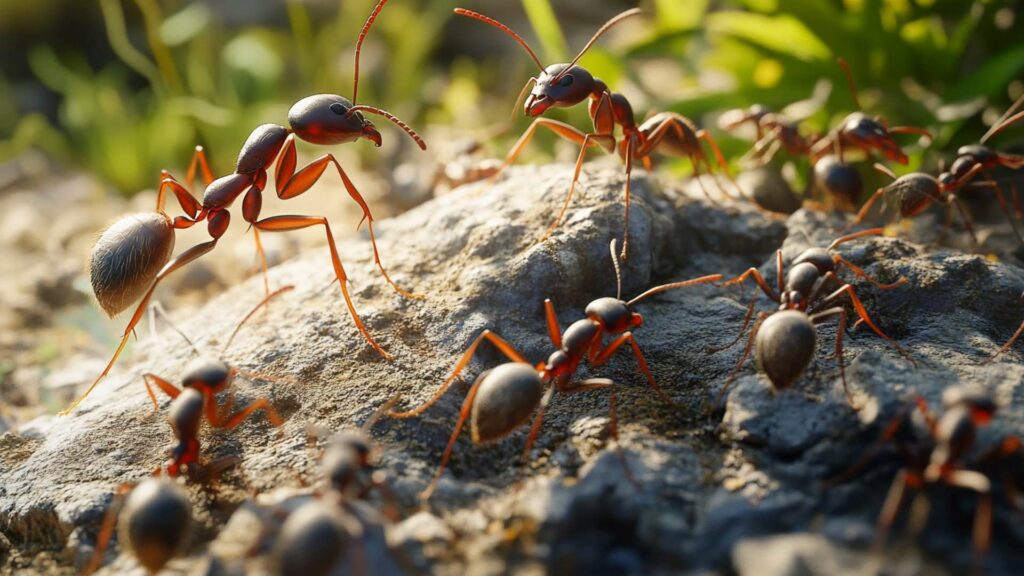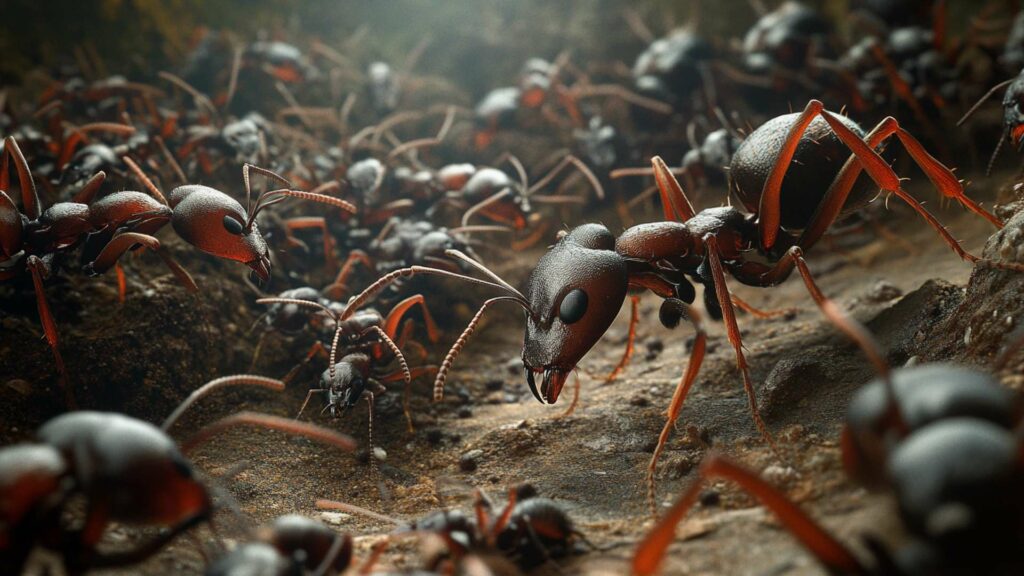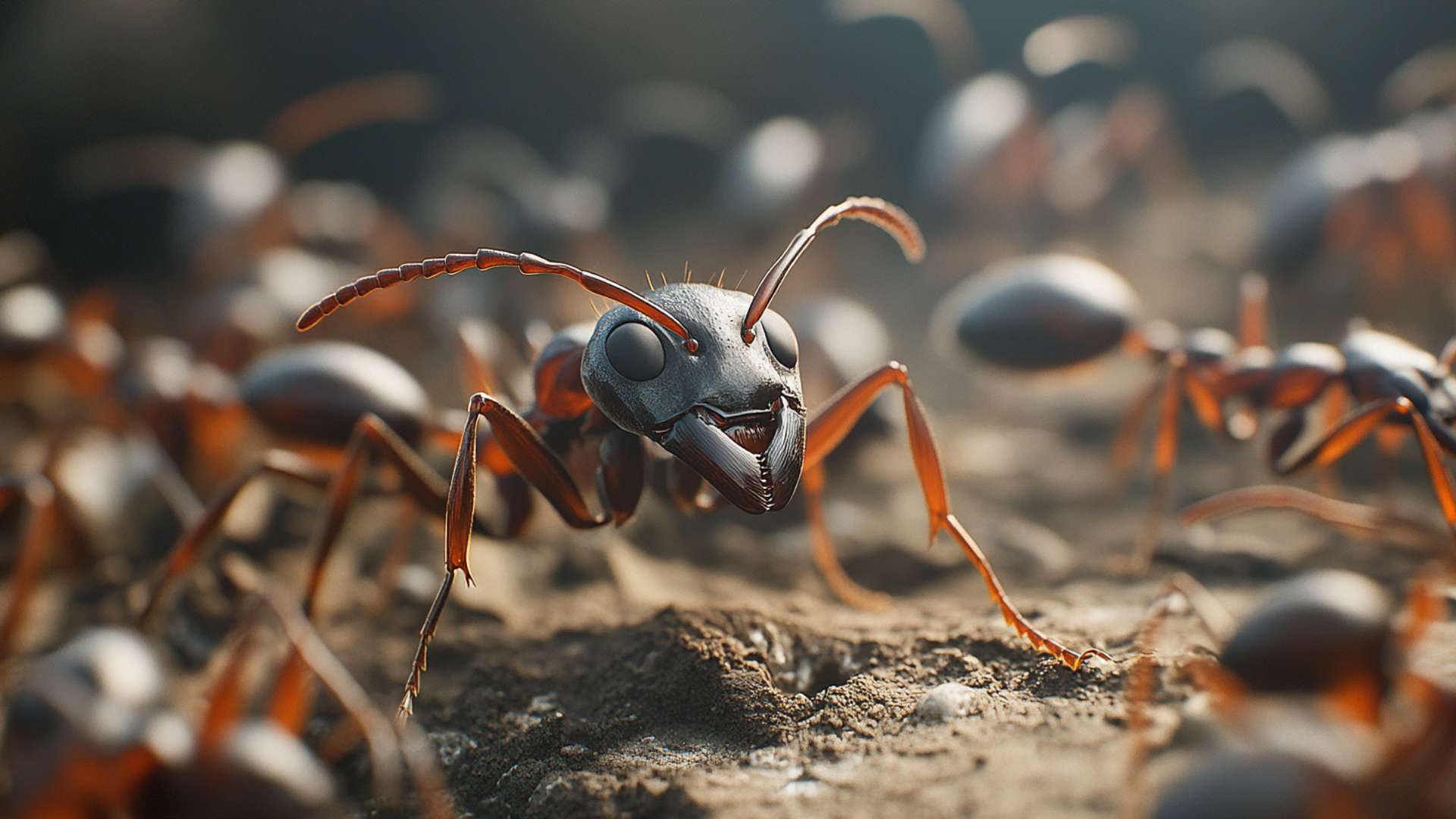Ants, those tiny creatures that scurry around tirelessly, are truly remarkable insects. With their intricate societies, complex communication systems, and unbelievable strength relative to their size, ants have captivated our curiosity for centuries. However, amidst all the marvels of these miniature organisms, a question arises: Do ants have hearts?
Brief Overview of Ants as Remarkable Insects

Ants belong to the order Hymenoptera and are closely related to bees and wasps. They have been wildly successful in adapting to various environments across the globe, colonizing almost every landmass except Antarctica. With over 12,000 known species of ants discovered so far, they display an incredible diversity in size, coloration, behavior, and habitat preferences.
Ants are social insects that live in colonies composed of individuals with different tasks or castes such as queens (reproductive females), males (drones), and workers (sterile females). These colonies of worker ants exhibit impressive coordination and division of labor, enabling them to build elaborate nests or anthills underground or within trees.
Do Ants Have Hearts?
The idea of ants having hearts may seem peculiar since we typically associate hearts with larger animals like mammals. However, when it comes to understanding an ant’s circulatory system more comprehensively, this question becomes crucial.
In humans and many other animals like birds or reptiles, the heart embodies a vital organ responsible for pumping blood throughout the body via a network of blood vessels. But do ants possess a similar mechanism to pump blood around?
Could there be an equivalent structure serving as their “heart”? To unravel this mystery and explore the fascinating world hidden within an ant’s body, let us delve into their anatomy and circulatory system.
Anatomy of an Ant
Ants are fascinating creatures that belong to the insect family, Formicidae. They are known for their highly organized societies and impressive teamwork. To understand whether ants have hearts, we first need to explore their anatomy.
Ants possess a segmented body structure, which consists of three main parts: the head, thorax, and abdomen. The head houses most ants’ vital sensory and control organs that allow ants to interact with the environment.
They have compound eyes that help them collect visual information and detect light. Additionally, they possess antennae, which serve as highly sensitive appendages used for communication and detecting chemical signals in their surroundings.
Moving on to the thorax of queen ants, this region is responsible for supporting the six legs that enable ants to scurry swiftly across surfaces. Inside the thorax lies one chamber of the ant’s circulatory system – an elongated tube known as the dorsal aorta.
We have the abdomen, which contains most of an ant’s vital organs such as its digestive system and reproductive organs. It is also home to another segment of the circulatory system called “aortic arches,” which act as pulsating organs responsible for propelling hemolymph through blood vessels present throughout their bodies.
The Ant Circulatory System
Unlike mammals with a closed circulatory system where blood is contained within vessels at all times, ants possess an open circulatory system. This means that instead of blood traveling exclusively within designated vessels like arteries and veins, they have a circulating fluid called hemolymph that bathes their internal tissues directly. The ant’s heart beats in a rhythmic pattern but differs from what we typically envision as a human ant’s heart rate.
In reality, they lack a centralized organ resembling our traditional understanding of hearts. Instead, they rely on specialized structures like the dorsal aorta and aortic arches distributed throughout their bodies.
The dorsal aorta, located in the thorax, acts as the primary vessel that helps transport oxygen and nutrients to various parts of the ant’s body. From this main artery, a few organs and smaller vessels branch out and carry hemolymph to all the vital organs.
Functioning without a Centralized Heart
Ants have evolved to function efficiently without a centralized heart. While it may seem unconventional compared to our human circulatory system, this adaptation works well for these tiny creatures. The hemolymph plays a crucial role in transporting oxygen and nutrients throughout an ant’s body and also aids in waste removal.
The absence of a centralized heart means that the circulation of hemolymph is not limited by set blood vessels. Instead, it flows more freely through interconnected spaces called sinuses or lacunae within their bodies.
This allows for efficient exchange of substances between the cells and interstitial fluid. Ants possess an intriguing anatomy that supports their unique circulatory system.
Although they lack a traditional centralized heart like mammals, they have adapted with specialized structures distributed throughout their bodies to ensure effective circulation of their vital circulatory fluid – hemolymph. Understanding how these systems work helps us appreciate the intricate biology present even within small creatures like ants.
The Ant Circulatory System
Insects, including ants, possess an open circulatory system. Unlike the closed circulatory system found in humans and other vertebrates, where blood is enclosed within vessels, ants rely on a different mechanism to transport vital fluids throughout their bodies.
Instead of blood vessels, they have a network of interconnected spaces called hemocoel that bathes their organs and tissues directly. This hemolymph is equivalent to the blood in our bodies and plays a crucial role in transporting nutrients, hormones, and immune cells.
Ants’ Version of a “Heart”
While ants do not have a centralized heart like the human heart pumping blood through arteries and veins, they possess unique structures that aid in circulating hemolymph effectively. One key component is the dorsal aorta, which acts as the main channel carrying hemolymph along the ant’s abdomen. It functions similarly to major arteries but without muscular contraction for propulsion.
The role of pulsating organs called “aortic arches” further contributes to circulation of ant organs. These arches are present throughout the ant’s body and act as auxiliary pumps.
They rhythmically contract and relax to create pressure gradients that help propel hemolymph forward through the various interconnected spaces. This coordinated pulsation ensures proper distribution of essential fluids within an ant’s segmented body.
The open circulatory system present in ants might seem quite different from our closed circulatory system with its intricate network of blood vessels, but it serves ants remarkably well. The absence of rigid tubes allows for flexibility in accommodating changes in body size during growth or accommodating environmental conditions such as squeezing through narrow passages within an ant colony or underground tunnels.
With this understanding of how the ant’s circulatory system operates, let’s explore some fascinating facts about these tiny creatures’ hearts.
Functioning without a centralized heart
Comparison with human circulatory system
When it comes to the circulatory systems of ants and humans, there are some intriguing differences. While humans have a closed circulatory system with a centralized heart, ants possess an open circulatory system, lacking a central pump.
In our bodies, the heart propels blood through a network of vessels, ensuring that oxygen and nutrients reach all organs and tissues. However, ants have evolved a unique mechanism to achieve similar results without a traditional heart.
Hemolymph – the ant’s blood equivalent

Instead of blood like fluid found in humans (containing red blood cells), ants have hemolymph flowing through their bodies. Hemolymph can be considered as an equivalent to our human blood, but with some differences. It is not contained within vessels like our circulatory system; instead, it flows freely within the ant’s open body cavity called the hemocoel, bathing their organs directly.
This fluid serves multiple purposes beyond just transporting nutrients and oxygen. The composition of ant hemolymph consists of water along with various proteins, ions, hormones, and cells called hemocytes dispersed within it.
The primary function of an ant’s hemolymph is to transport nutrients from the digestive system to different organs and tissues throughout the ant’s body. Additionally, it plays essential roles in waste removal by carrying metabolic byproducts away for excretion.
Ants are fascinating creatures because their unique adaptations allow them to thrive despite not having a centralized heart or traditional circulatory system like ours. Their decentralized open circulatory system enables efficient distribution of resources without relying on high-pressure pumping mechanisms like human hearts do.
Overall, while ants may lack what we traditionally think of as a “heart,” they have developed an equally effective way – through their open circulatory systems using hemolymph – to ensure the basic function of supplying nutrients and oxygen to their organs and tissues. It is yet another testament to the remarkable diversity and ingenuity found in the natural world.
Adaptations for Efficient Circulation in Ants
Ants are fascinating creatures that have evolved remarkable adaptations to facilitate their circulation despite their small size and decentralized nature. Unlike humans, ants do not have a closed circulatory system with a centralized heart pumping blood through intricate networks of blood vessels. However, they have developed alternative mechanisms to efficiently distribute vital nutrients and oxygen throughout their bodies.
One adaptation that aids circulation in ants is their small size. Due to their miniature stature, ants have a higher surface-to-volume ratio compared to larger organisms.
This means that they can exchange gases, such as oxygen and carbon dioxide, more effectively through their body’s surface area. Additionally, the decentralized nature of an ant’s circulatory system minimizes the distance between cells and vital organs, allowing for rapid nutrient delivery.
Antennae and Spiracles Aiding Oxygen Exchange

Ants utilize several unique features to facilitate oxygen exchange within their bodies. One such feature is the presence of antennae on their heads ant bodies. These sensory appendages not only help ants collect visual information about their surroundings but also play a crucial role in respiration.
The thin tube-like structures present in the antennae known as tracheae allow for the diffusion of gases, enabling ants body to efficient oxygen intake while expelling carbon dioxide. In addition to antennae, spiracles are another essential component involved in respiration for ants.
Spiracles are small openings located along the sides of an ant’s body or abdomen through which oxygen enters and carbon dioxide exits the insect’s respiratory system. By actively opening and closing these spiracles, ants can regulate gas exchange according to metabolic demands.
Limited Distance Between Cells for Effective Nutrient Delivery
Efficient nutrient delivery is crucial for any organism’s survival, including ants. Despite not having a closed circulatory system, ants have evolved a decentralized network of interconnected tubes called the dorsal vessel or “heart.” This thin tube runs along the ant’s back, enabling the transport of hemolymph, the ant’s equivalent of blood. The absence of blood vessels necessitates an alternative mechanism for nutrient delivery.
Ants use a system known as interstitial fluid circulation. The interstitial fluid bathes the cells directly, allowing for direct exchange of nutrients and waste products.
As a result, ants have limited distance between their cells and vital organs, ensuring efficient nutrient delivery and waste removal. Ants have developed an array of adaptations similar to blood to ensure efficient circulation despite not having a closed circulatory system like humans.
Their small size, decentralized nature, antennae for oxygen exchange, spiracles for respiration regulation, and interstitial fluid circulation mechanism all contribute to their impressive ability to distribute vital resources effectively throughout their bodies. These adaptations highlight the wonders of nature’s diversity and emphasize that even creatures as small as ants have intricate physiological systems that enable their survival within an ant colony or in various environments.
Fascinating Facts About Ant Hearts
Ants, with their intricate social structures and diverse species, showcase an astonishing range of heart structures. Just as ants vary in size, behavior, and ecological role, their hearts exhibit adaptations tailored to their specific needs. Let’s explore some remarkable examples.
Examples include Carpenter Ants, Leafcutter Ants, etc.
Carpenter ants (Camponotus spp.) are renowned for their ability to excavate wood and build elaborate nests. These industrious insects have relatively large hearts that enable efficient circulation throughout their robust bodies.
Their hearts exhibit complex branching patterns to deliver hemolymph—the ant’s circulatory fluid—to all extremities efficiently. On the other hand, leafcutter ants (Atta spp.) are known for their proficiency in agricultural practices.
These tiny farmers cut leaves and use them as a substrate for cultivating fungi within their nests. The hearts of leafcutter ants differ from those of carpenter ants; they possess a more streamlined structure suitable for the smaller bodies of these diligent workers.
Variations in Heart Anatomy Based on Species’ Needs
Interestingly, among different species of ants, variations in heart anatomy reflect specific physiological requirements dictated by varying lifestyles or ecological niches. While certain ant species have larger hearts with increased muscle mass to support demanding activities such as foraging or long-distance migrations, others may have more compact hearts optimized for energy conservation.
For instance, army ants (Eciton spp.), who embark on nomadic predatory raids in search of prey items like a terrifying army on the move, possess specialized heart adaptations. Their hearts tend to be elongated and segmented into multiple chambers to accommodate rapid changes in hemolymph distribution during dynamic hunting expeditions.
Intriguingly enough, some ant species have hearts that can adjust their pumping rate in response to external stimuli or internal conditions. This adaptability allows them to regulate circulation and respond swiftly to varying demands within the colony or even in different life stages.
The diversity in ant heart structures highlights the remarkable plasticity of these tiny organisms’ circulatory systems, fine-tuned by evolutionary forces to suit their specific ecological niches. As we delve into the marvelous world of ants hearts, we uncover an astonishing array of heart adaptations that cater to their varied needs.
From carpenter ants with intricately branched hearts facilitating efficient hemolymph distribution throughout their bodies, to leafcutter ants with streamlined hearts optimized for their smaller frames, each species has its own unique cardiac architecture. These adaptations showcase nature’s ingenious designs and remind us how diverse and fascinating life can be—even within the miniature universe of ants.
Evolutionary Significance

The intricate circulatory system found in ants is a testament to the wonders of evolution. Over millions of years, these fascinating creatures have adapted their circulatory system to suit their diverse lifestyles and environments.
The evolution of the ant’s circulatory system has played a crucial role in their success as social insects, enabling them to thrive and survive in various conditions. One key aspect that shaped the ant’s circulatory system is their transition from a closed circulatory system, like that of humans, to an open circulatory system.
This change occurred as ants evolved to become smaller in size and developed complex social structures. The adoption of an open circulatory system allowed for greater flexibility and efficiency in delivering nutrients and oxygen throughout their bodies.
Adaptation to Various Environments and Lifestyles: A Fluid Journey
The ant’s adaptation to various environments is evident through its remarkable fluid transport system. Unlike humans whose red blood cells carry oxygen, ants rely on a fluid called hemolymph that serves multiple purposes within their bodies.
This hemolymph not only transports nutrients but also plays a vital role in waste removal and immune responses. In addition to adapting their circulatory systems for general survival, different ant species have further specialized based on their specific lifestyles.
For example, carpenter ants, which excavate wood galleries for nesting purposes, require greater circulation efficiency due to increased physical activity involved in nest building activities. Leafcutter ants, on the other hand, have developed an even more sophisticated circulation system as they carry heavy loads of leaf fragments back to the colony for fungal farming.
As we delve into understanding the evolutionary significance behind the ant’s remarkable circulatory system, it becomes clear how nature has shaped these incredible creatures over eons. From transitioning to an open circulatory system to adapting to various environments and lifestyles, ants have developed a highly efficient means of transporting nutrients, oxygen, and waste throughout their bodies. Through evolution, the ant’s circulatory system has become intricately intertwined with other vital systems such as their tracheal system for respiration and their sensory and control organs for navigation.
The decentralized nature of the ant’s circulation allows for efficient nutrient delivery to cells while maintaining an impressive level of adaptability. The next time you observe a bustling column of ants or marvel at their ability to carry objects many times their body weight, take a moment to appreciate the evolutionary journey that has shaped not only their circulatory system but also the overall success of these incredible insects.
Conclusion
Recapitulation of key points on ant hearts
Throughout this exploration into the intricate world of how ants breathe, we have delved into the question of whether these fascinating creatures possess hearts. By examining their anatomy and circulatory system, it is clear that ants do not have a centralized heart like humans do.
Instead, they rely on a decentralized network of aortic arches and a dorsal aorta to pump their equivalent of blood – hemolymph – throughout their bodies. This hemolymph flows freely through their interstitial fluid and bathes all the vital organs, ensuring efficient nutrient delivery and waste removal.
Final thoughts on the marvels of nature’s diversity
Studying the complex mechanisms that enable ants to survive and thrive in their environments gives us great insight into the marvels of nature’s diversity. The fact that ants have evolved such an efficient circulatory system without a centralized heart is awe-inspiring. These tiny creatures have adapted to various habitats, from leafcutter ants bustling with activity in tropical rainforests to carpenter ants quietly constructing elaborate nests in our own backyards.
Their ability to communicate through chemical signals, navigate vast distances in search of resources, and work harmoniously within an ant colony showcases the remarkable intricacy and resilience found in even the smallest corners of our world. In closing, while it may be accurate to say that ants don’t possess hearts as we traditionally understand them, this does not diminish their remarkable biology or importance within ecosystems worldwide.
Ants are truly captivating creatures with unique adaptations that allow them to thrive in diverse environments. As we continue unraveling nature’s mysteries, let us find inspiration in these tiny wonders and appreciate how every organism plays its part in maintaining balance on our planet.
Prevent Ant Infestations with D-Termination: Las Vegas’ Top Pest Control Choice!

If you’re dealing with ant issues, D-Termination is here to help. Our experienced team specializes in deterring ants, revitalizing cleanliness, and preserving the integrity of your area. Bid farewell to ants—select D-Termination for effective pest control today!
Get in touch with us at 702-919-6310 or visit dtermination.com to schedule your ant control service and regain control of your space from these unwelcome pests.
Frequently Asked Questions:
Ants have a simple circulatory system and a rudimentary brain.
Ants likely do not feel pain as humans do.
Ants do have a pulsating circulatory system, but it’s different from mammals.
Ants do not have emotions like humans; their behavior is primarily driven by instincts and chemical signals.








